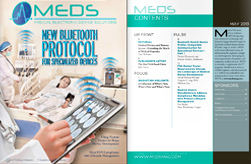West Health Institute demonstrates research advances in medical device interoperability to lower the cost of health care
Standards-based software and tools to be on display at HIMSS13 Interoperability Showcase
SAN DIEGO, CA – Feb. 28, 2013 – The Gary and Mary West Health Institute, an independent, non-profit medical research organization whose mission is lowering the cost of health care delivery, has collaborated on a research demonstration for the HIMSS13 Annual Conference that enables seamless, standards-based communication between medical devices and information systems. It will be featured at the HIMSS13 Interoperability Showcase on March 4-6, in New Orleans, LA.
This demonstration of software-based interoperability is part of a collaborative research effort with Wind River, a world leader in embedded and mobile software, and the U.S. Commerce Department’s National Institute of Standards and Technology (NIST) to achieve interoperability starting at the patient’s point-of-care medical device’s interfaces all the way through to their electronic health record (EHR). The approach is expected to simplify health information technology (HIT) requirements and improve the delivery of care through a patient-centered network of connected and coordinated devices.
“As we’ve heard from our hospital partners, health care technology needs to seamlessly work together to communicate and exchange data,” said Nicholas Valeriani, chief executive officer of the West Health Institute. “We support efforts to advance health care technology with tools that make it easier for manufacturers to implement standards that could improve patient care and reduce the cost of health care.”
In a hospital today, patients in an Intensive Care Unit (ICU) are typically treated using six to 12 medical devices, including defibrillators, electrocardiographs, vital signs monitors, ventilators and infusion pumps. These devices are often from different manufacturers that use incompatible communication technologies and are therefore not easily integrated, requiring a costly, complex IT infrastructure. This also introduces the potential for miscommunication, adversely impacting both the patient and the timely, well-informed delivery of care, ultimately driving up the cost of health care.
About the Demonstration
The demonstration, “Medical Device Integration: Completing the Last Mile” is Use Case 18 of the HIMSS13 Interoperability Showcase. Leveraging profiles from Integrating the Healthcare Enterprise (IHE), the HIT Innovations demonstration will show how software, tools and reference designs can allow for end-to-end medical device interoperability.
Specifically, the demonstration shows how point-of-care integration can occur at the device interface. This use case displays how West Health Institute-developed research software, when placed on Wind River’s operating systems, is able to move real-time information from an infusion pump to a data integrator or hub. Status updates from a patient’s simulated infusion pump – including alarm conditions – flow seamlessly from the device interface to an electronic medical record and a clinician’s smart phone via completely interoperable standards. The information exchange is consumed and validated against standards via NIST’s publicly- available test tools.
“The current lack of medical device interoperability is one of the more daunting challenges slowing the integration of advanced technologies in health care, and a major barrier to connectivity in the hospital setting,” said Santhosh Nair, general manager of intelligent systems group at Wind River. “Through this collaboration, we are demonstrating that seamless standards-based communications directly from medical devices is possible.”
West Health Institute and Wind River, along with other organizations, are collaborating with NIST to facilitate the development and adoption of standards for medical device communications throughout the health care enterprise, as well as integrating it into the electronic health record. NIST’s free conformance test tools work across a variety of health care domains including message validation of medical devices. The industry has adopted and made use of the tools enabling standards-based approaches and feedback, leading to improved medical device data communication and more accurate standards.
“Despite the great work on interoperability standards to date, including profiles published by IHE, as an industry we continue to fall short on adoption of these standards,” said Joyce Sensmeier, vice president of informatics for the Healthcare Information and Management Systems Society (HIMSS). “I am thrilled that the HIT Innovations demonstration shows how standards integration from EHR to the device is possible to improve patient safety and drive down costs.”
ABOUT THE WEST HEALTH INSTITUTE
The Gary and Mary West Health Institute is an independent, non-profit 501(c)(3) medical research organization whose mission is to lower health care costs by developing innovative, patient-centered solutions that deliver the right care at the right place at the right time. This is accomplished by conducting innovative medical research, educating key stakeholders and advocating on behalf of patients. Solely funded by pioneering philanthropists Gary and Mary West, the Institute is part of West Health, an initiative combining four separate organizations – the West Health Institute, the West Health Policy Center, the West Health Investment Fund and the West Health Incubator. The Institute is located in San Diego, California, the global center for health care innovation. For more information, find us at www.westhealth.org and follow us @westhealth.
ABOUT THE HIMSS INTEROPERABILITY SHOWCASES
Touted as the nation’s premier forum highlighting the Integrating the Healthcare Enterprise’s (IHE) common framework, the HIMSS Interoperability Showcases brings solution providers and decision-makers together in a “seeing is believing” interactive environment where attendees can become the patient in a clinical use case scenario and watch their health data move from system to system.

